
Preservation efforts battle nature, budgets
DRY TORTUGAS, Fla.— Despite the constant efforts by the National Park Service to preserve Fort Jefferson and Dry Tortugas National Park, lack of money and resources has caused the 150-year-old fort to deteriorate and collapse in some of its areas.
With a recent $15 million renovation contract awarded, the park service is looking for a company that will have enough manpower to stabilize the fort in a project that can last anywhere from one to five years.
“Fifteen million is not enough,” said Mike Ryan, lead interpretive ranger at Dry Tortugas National Park, who has been living in the fort for almost three years. “But it will get the majority of the things that need to be done.”
Fort Jefferson is located almost 70 miles west of Key West. The construction phase began in 1846 and continued for 30 years, but the project was never finished.
During the Civil War, the fort served as a prison for captured deserters, until the Army finally abandoned it in 1874. After being abandoned for several years, President Franklin Roosevelt designated the fort and the surrounding water as a national monument in 1935.
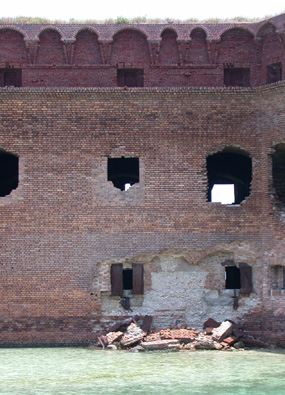 |
These bricks, ravaged by sea, wind, and age, have fallen from the exterior fort wall (Staff photo). |
In 1992, the area was re-designated as Dry Tortugas National Park to protect the historical and national features. The fort is well known for the numerous sea turtle nests and coral reefs in the surrounding area.
“I think it’s really important to keep it [the fort] up,” said Tammy Campbell, 42, and resident of the island for five years. “Not only for the natural resources and its history, but because it’s an amazing place.”
Over 16 million bricks were used to construct the fort, but due to rain storms, marine life, and iron used to construct embrasures and shutters, the fort has been deteriorating for the past century.
The salty water has caused the iron to rust and expand, causing the adjacent masonry walls to crack and fall into the moat.
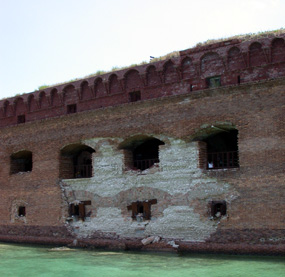 |
Damage from the environment and age is apparent in this section of the exterior wall of Fort Jefferson (Staff photo). |
“This is a solid force,” said Niki Ryan, 31, who has been living in the island for 2½ years. “But it is unsafe with all the mortar and bricks falling out.”
The walls are 50 feet high and 8 feet thick.
The stabilization and preservation plan includes hiring a group of people that can live on the fort and work full time for the duration of the project. The project consists of two phases.
Phase one consists of stabilizing the lower level embrasures, including removal of the iron embrasures and shutters, replacing bricks and repointing as needed.
The rubble pile that was caused by the destruction of the officer quarters in the 1960s, located outside the fort and east of the moat wall, would be ground up and used as fill for embrasure repair.
Currently, the campgrounds on Garden Key have been closed during 2003. Sewage and drainage system repairs have been required.
With placement of new composting toilets in addition to the repairs, the campgrounds as well as other resources at the fort will be improved for visitors.
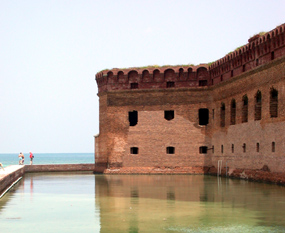 |
The moat and a repaired exterior wall (Photo by Yu He). |
Due to lack of funding, the needed sand for repair work would come from local sources.
The sand would be excavated down to the high tide line from the land bridge connecting Garden Key [island where Fort Jefferson is located] and the adjacent island, Bush Key.
This process has not yet been decided on though, since the other option would be to import the sand. The cost of importing material will cost more than the purchase of the material, said Ryan.
The second phase consists of repairing the upper level embrasures, parade walls, stair towers, casemates and replacing lintels. This phase would require scaffolding and the exterior walls below the water line would also be checked and tested by using cofferdams to temporarily displace moat water.
Beginning June 1, 2003, visitors are required to pay a $5 fee for admission to the park.
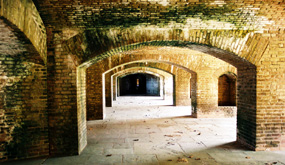 |
Interior fort arches show the wear of age (Staff photo). |
Dry Tortugas was one of the few parks in the county that did not charge for admission.
Biscayne National Park does not charge admission for vehicles. The Everglades National Park charges $10 for a private vehicle for seven days.
Now, Dry Tortugas National Park will collect admission fees to continue with the stabilization and preservation plan.
“It’s important to preserve something like this,” said Victoria Davis, 47, on her first visit to the fort. “It’s part of history.”
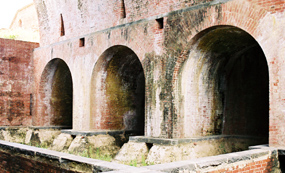 |
The brick of the fort’s magazine may be stained by age, but it remains in better shape than some of the fort’s outer walls (Photo by Chris Rivera). |
The admission fees were not being charged at the time of her visit, but Davis said she would not mind to pay $5 to visit the park in the future.
Chandra Robinson, 28, who was also visiting the park for the first time agreed to the importance of preservation.
“Without preservation, we couldn’t have places like these,” said Robinson. “This is history and I want my grandchildren to see it.”
Even though the exact stabilization plan has not been finalized and the national park service awaits the services of a contractor, stabilization is on its way, slowly but surely, said Niki Ryan.

Comments are Closed